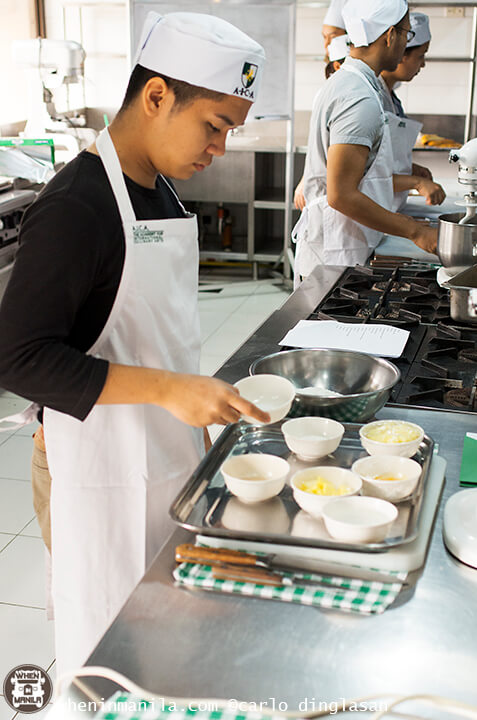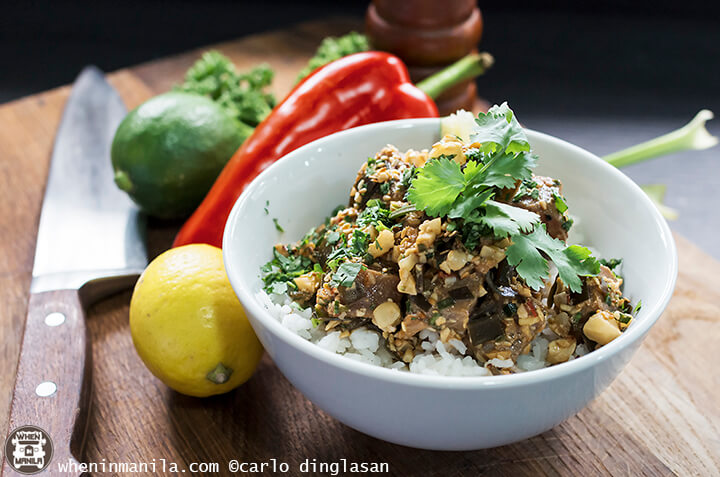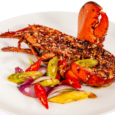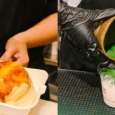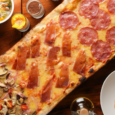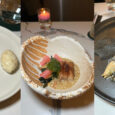To begin with, let me just say that I have little knowledge when it comes to cooking. Sure, I know the basics: broiling, dicing, sauteing, etc. I learned those from my parents or from the shows I watch, but that’s about it. Despite my interest in cooking, I just didn’t have a venue to learn more advance techniques. So when I had the chance to feature a culinary school, I was ecstatic.
The school we enrolled in for a day is named The Academy for International Culinary Arts or AICA. It has been around since 2004 with top professionals of different expertise training the students hands-on using only the finest equipment and ingredients.
They have four diploma courses: Diploma for International Culinary Arts and Restaurant Operations, Diploma for World Cuisines and Professional Kitchen Management, Diploma in Baking and Pastry Arts, and the Premiere Diploma Program. We were immersed in the Premiere Diploma Program wherein students were taught to be well-rounded. This course is suitable for starters because they would get the chance to tap into every aspect and later on realize which department suits them best.
The courses in AICA are usually 6 months long, but a day is already enough for us—or me, for that matter—to get a grasp on what it feels like to be a culinary student, so allow me to share a day in the life of a culinary student in the eyes of an amateur cook.
9 AM
Do you remember that first-day-of-school excitement? This is what I felt that day. Our call time was 9 in the morning, but I arrived there earlier. When the class started, we proceeded to the lecture room first where we did our introductions.
There were two professional instructors with us that day: Chef Marlon Palomares and Chef B Camposana. Chef Marlon specializes in international cuisine as he worked in the US for many years. Chef B, on the other hand, focuses on nutrition and baking and pastry arts. They gave a few background about the school and talked about how every modern and trending food originates from a traditional form of cooking which we would learn afterward.
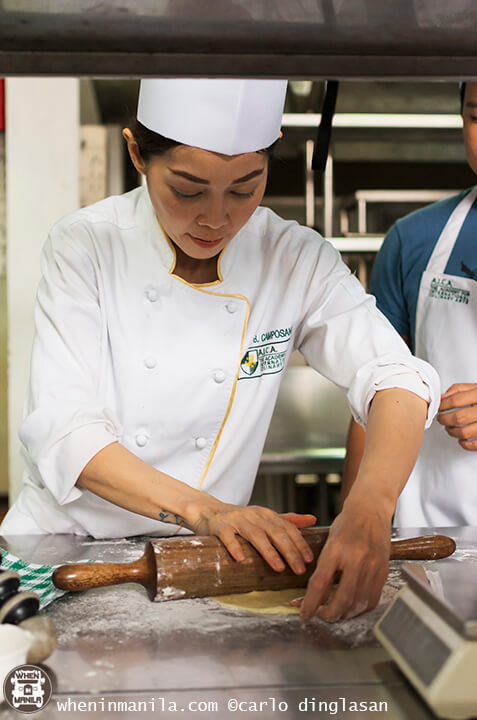
10 AM
After a few lectures, we went on with the hands-on activities. Learning via discussion is important, but application is always the key to fully understand the concepts and techniques.
The kitchen station was impressive. It’s exactly what you’re probably thinking right now—gleaming with spotless, high-end equipment. They have various stations: sanitary, grilling, frying, baking, cooling, and workstations for the students and lecturer. From that moment, it’s impossible not to feel excited about how the class will go. For that day, we were asked to cook a lot of dishes. To name some, there’s the potato rolls, maui ahi poke, chimichurri, refried beans, tortilla, mayonnaise, mashed purple yam, and many more.
READ: DIY Poké: My Quick and Healthy FastFood Choice
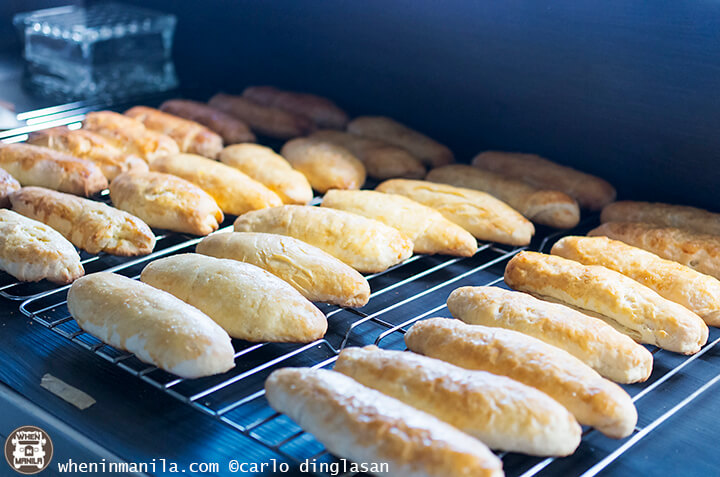
We were given handouts containing the recipe and started with the actual program. The handouts were simplified, which makes it easy for even beginners to comprehend. The chefs also made it easier by being very hands-on with their teaching. After explaining about the dish and demonstrating how it’s done, they walk around and check if the students are doing it right.
I have tried cooking before, so following the chefs’ instruction was relatively easy enough. The challenging part is that you just have to know how to multi-task. You don’t wait for each dish to be complete. For example, while letting the sauce simmer down, you’re already asked to start on the next dish as to not waste time.
12:30 PM
By this time, believe it or not, all of us students were already tired. We didn’t expect it to be like that. We were having fun and all, but we were legitimately tired. Standing the whole time and shuffling here and there get extra hard with the heat of the kitchen getting to us. Personally, I had many breaks just to drink water.
When lunchtime came, we were relieved. We all sat down sluggishly and appreciated the food, the comfort of sitting, and the cold, refreshing drinks.
One of the students even shared, “Nako, kaya mga tao dapat nau-understand maging mabait talaga tayo sa mga chef o waiter! Nakakapagod!” And I agree with it wholeheartedly. I actually wanted to sleep right after eating, but our day wasn’t done yet.
PS: Our lunch was the food that we made. It was delicious thanks to the detailed recipe!
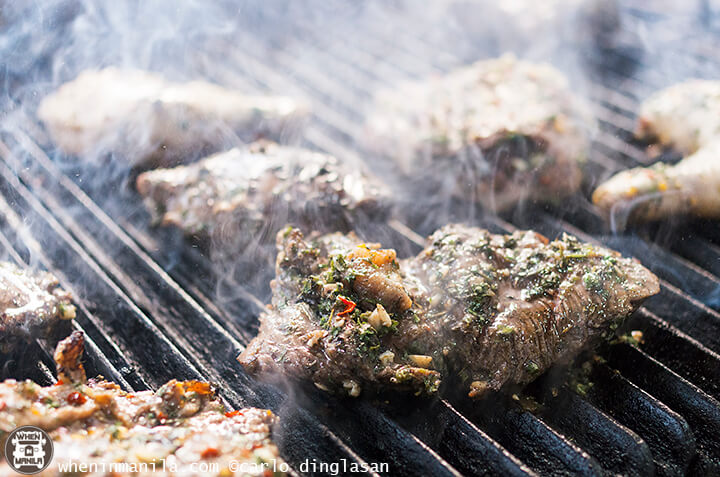
2 PM
The break rejuvenated our energy and we were energized again to start with new dishes. It was around this time when I realized that AICA really values discipline and teamwork. The main chefs give instructions to everyone and people do it hand-in-hand. They were also disciplined in a way that everything must be clean—from the workplace and especially the hands. We were encouraged to wash our hands well and other basics such as wear the hair net and etc.
AICA is truly teaching that culinary schools aren’t just about the cooking. It’s forming other values, as well, which I really admired.
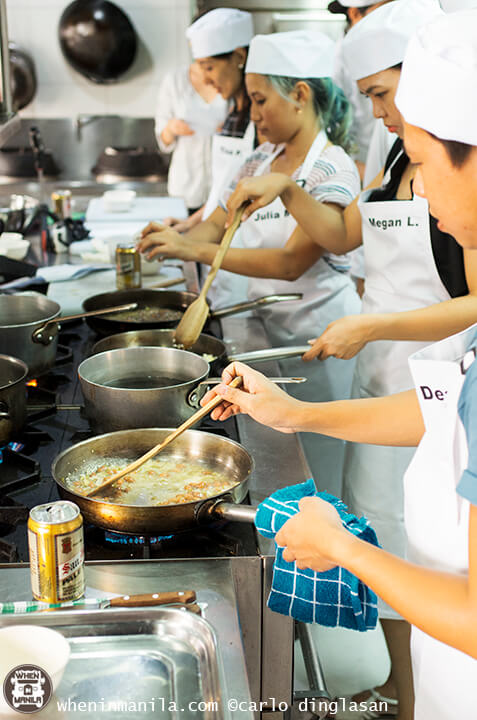
For the last hour, we were now assembling everything. It was emphasized here that plating is as important as the taste of the food. It’s amazing to see the chefs plate the food fast while still hitting that aesthetic spot on.
4 PM
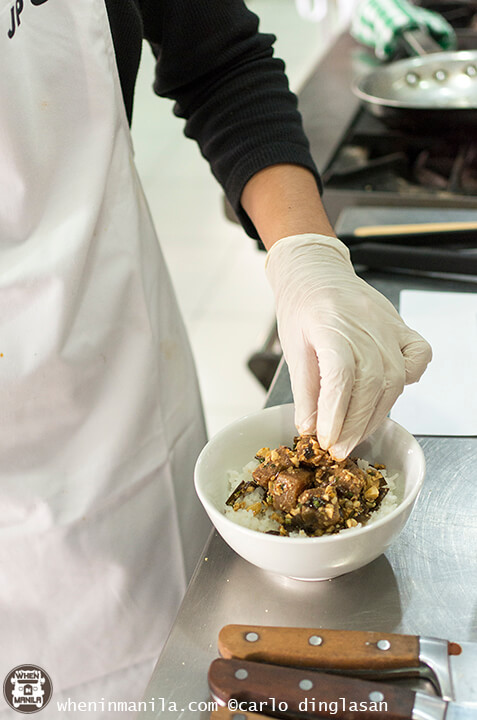
We wrapped up the class after the food plating (and of course the eating). The overall experience was excellent. Aside from gaining more knowledge about cooking, I got to met new people. It got me thinking how the cooking industry is a great way to really get to know a person’s character since you’ll see how they act under pressure and stress.
Again, it was still tiring overall. I couldn’t wait to go home and bum around. But to be honest, the thought of tiredness lessens when you get that sense of satisfaction—knowing you did okay, you have new skills/food to share to your loved ones, and you survived the day! That’s the pleasure of culinary arts for what it’s worth.
That’s just my thoughts about the day of being a culinary student, but I definitely won’t forget it. If you want to attend a cooking school, try inquiring at AICA. It’s going to be a very nice start to propel you in your culinary journey.
Salute to all chefs out there for their hard work and coming up with good food! (Why don’t we have a Chef Appreciation Day?)
Extra: Since I loved this recipe so much, I’d share how we made the Maui Ahi Poke. I’m not a fan of raw fish, but this made me a believer (honest to God).
1/4 cup – Soy Sauce
2 t – Sesame Oil
1 tsp – Grated Ginger
1/3 cup – Thinly Sliced Green Onion
1 t – Finely Chopped Kombu
1/2 tsp – Red Pepper Flakes
1 pound – Sushi-Grade Ahi (Yellowfin) Tuna, cut into large dice
1 tsp – Toasted Sesame Seeds
Kosher Salt and Pepper to taste
Crushed Macadamia Nuts to your content
Step 1: Whisk soy sauce, sesame oil, grated ginger, sliced green onion (not all), kombu, red pepper flakes in a bowl. Add as much crushed macadamia nuts as you like. Add salt and pepper to taste.
Step 2: Place cube tuna in a bowl. Pour in the marinade and stir to distribute evenly.
Step 3: Cover and Refrigerate for 2 hours.
Step 4: Mix again and serve in a bowl. Top with toasted sesame seeds, more sliced green onions, and sprinkle with lemon/lime/Seasoned Rice Vinegar to make it more fresh.
–
You may visit or call the Academy for International Culinary Arts (AICA) in their Manila and Cebu branches through the details found below:
Manila Business Address:
Suite 207 Skyway Twin Towers #351 Capt. Henry Javier street Pasig City, Philippines
Tel: +632.671.0276/77 & 6722271
Email: manila@aicaculinary.com
Cebu Business Address:
The Gallery
Juan Luna Street Cor. Golam Drive
Mabolo, Cebu City, Philippines
Tel: +6332.316.4828
Email: aicacebu@yahoo.com
Facebook: www.facebook.com/AICAculinaryarts/
Website: www.aicaculinary.com

